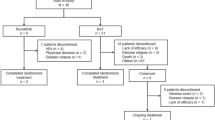Summary
Immunosuppressive therapy for liver transplantation has been greatly improved with the introduction of immunosuppressive agents such as cyclosporin and tacrolimus in the 1980s and the 1990s, respectively. These agents inhibit transcription of the messenger RNA for cytokines such as interleukin-1, interleukin-2 and interferon-γ, thus inhibiting cytokine release from activated T cells, which in turn leads to inhibition of proliferation of killer T cells after transplantation. These cytokine inhibitors are combined in multidrug therapy with corticosteroids and/or other immunosuppressive agents with different mechanisms of action to obtain maximal efficacy and minimal adverse effects. This article focuses on immunosuppressive regimens using the highly selective immunosuppressant tacrolimus for liver transplantation, based on our 6 years experience of living-related liver transplantation and on the reports of cadaveric liver transplantation from other centres. Tacrolimus, like cyclosporin, has reduced the required dosage of corticosteroids, leading in several centres to successful corticosteroid withdrawal in 6 months to 1 year after transplantation. Further modification of immunosuppressive regimens in long term patients, including withdrawal of tacrolimus, will be required.
Access this article
We’re sorry, something doesn't seem to be working properly.
Please try refreshing the page. If that doesn't work, please contact support so we can address the problem.
Similar content being viewed by others
References
Calne RY, White DJG, Thiru S, et al. Cyclosporine A in patients receiving renal allografts from cadaver donors. Lancet 1987; II: 1323–7
Opelz G. Effect of the maintenance immunosuppressive drug regimen on kidney transplant outcome. Transplantation 1994; 58: 443–6
Starzl TE, Todo S, Fung JJ, et al. FK-506 for liver, kidney and pancreas transplantation. Lancet 1989; II: 1000
Ramos HE, Reyes J, Abu-Elmagd K, et al. Weaning of immunosuppression in long-term liver transplant recipients. 13th Annual Meeting of the American Society of Transplant Physicians; 1994 May 16–18; Chicago, 103
Donald EH, Wassim YA, Terry BS. Trends in the use of glucocorticoids in renal transplantation. Transplantation 1994; 57: 979–89
Padbury RTA, Gunson BK, Dousset B, et al. Steroid withdrawal from long-term immunosuppression in liver allograft recipients. Transplantation 1993; 55: 789
Kino T, Hatanaka H, Miyata S, et al. FK-506, a novel immunosuppressant isolated from streptomyces. II. Immunosuppressive effect of FK-506 in vitro. J Antibiot (Tokyo) 1987; 40: 125
Lie J, Farmer JD, Lane WS, et al. Calcineurin is a common target of cyclophilin-cyclosporin A and FKBP-FK-506 complexes. Cell 1991; 66: 807–15
Kino T, Hatanaka H, Miyata S, et al. FK-506, a novel immunosuppressant isolated from a streptomyces. J Antibiot 1987; 40: 1256–65
Yang WM, Inouye CJ, Seto E. Cyclophilin A and FKBP12 interact with YY1 and alter its transcriptional activity. J Biol Chem 1995; 270: 15187–93
Venkataramanan R, Jain A, Warty VS, et al. Pharmacokinetics of FK-506 in transplant patients. Transplant Proc 1991; 23: 2736
Mehta MU, Venkataramanan R, Burckart GJ, et al. Effect of bile on cyclosporine absorption in liver transplant patients. Br J Clin Pharmacol 1988; 25: 579–84
Cosimi AB, Colvin RB, Burton RC, et al. Use of monoclonal antibodies to T-cell subsets for immunologic monitoring and treatment in recipients of renal allograft. N Engl J Med 1981; 305: 308–14
Norman DJ, Barry JM, Funnell B, et al. OKT-3 for treatment of acute and steroid- and ATG-resistant acute rejection in renal allograft transplantation. Transplant Proc 1985; 17: 2744–7
Ueda M, Uemoto S, Inomata Y, et al. A proposal of FK-506 optimal dosing in living related liver transplantations. Transplantation 1995; 60: 258–64
Author information
Authors and Affiliations
Rights and permissions
About this article
Cite this article
Ueda, M., Tanaka, K. Choosing an Immunosuppressive Regimen for Liver Transplantation. BioDrugs 8, 430–438 (1997). https://doi.org/10.2165/00063030-199708060-00003
Published:
Issue Date:
DOI: https://doi.org/10.2165/00063030-199708060-00003




